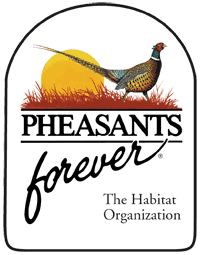Pheasants Forever Announces 2013 Minnesota Habitat Accomplishments
Pheasants Forever 01.31.14

Organization celebrates 70,000 acres of wildlife conservation at recent state meeting in Granite Falls
Pheasants Forever’s (PF) mission work in Minnesota improved wildlife habitat on more than 70,000 acres in 2013, conservation projects that are simultaneously preventing soil erosion and improving water quality. PF held its annual state meeting on January 18th to recognize these efforts and the volunteers that made these accomplishments possible.
Pheasants Forever was formed in Saint Paul in 1982, and since that time, “The Habitat Organization” has grown to 76 chapters and more than 26,000 Pheasants Forever and Quail Forever members in Minnesota alone. Nationwide, Pheasants Forever, and its quail conservation division, Quail Forever, have a combined 140,000 members and 740 chapters located across North America. The nonprofit conservation organization continues to be recognized as a 4-star charity by Charity Navigator, the largest charity evaluator in the country.
“The Minnesotans who support Pheasants Forever’s habitat mission are truly amazing, and their efforts have allowed us to accomplish such significant projects for Minnesota over Pheasants Forever’s 31-year history,” stated Eran Sandquist, PF’s Regional Biologist for Northern Minnesota. “Now is not the time to rest, though. While we celebrated 31 years of accomplishments, we also looked to the horizon to see the many challenges and pressures the state’s landscape faces during the coming years. Most importantly, we discussed how to work to ensure these challenges do not limit Minnesota’s long outdoor heritage, and a strong habitat-based landscape is the key.”
| Type of Project | 2013 Projects | 2013 Acres | Historical Project Totals | Total Acres Benefited |
| Nesting Cover | 59 | 1,572 | 3,376 | 64,486 |
| Land Acquisition* | 25* | 3,574* | 438* | 39,814* |
| Wetland Restoration | 50 | 65 | 510 | 10,787 |
| Winter Cover | 17 | 10 | 4,408 | 10,363 |
| Food Plots | 611 | 3,212 | 16,927 | 87,892 |
| Habitat Maintenance | 80 | 2,013 | 731 | 27,617 |
| TOTALS | 842 | 10,446 | 26,390 | 240,958 |
Additionally, Pheasants Forever’s Habitat Teams restored or enhanced 7,381 acres in cooperation with farmers and private landowners. Work included 3,713 acres of grassland restoration and 3,668 acres of prescribed fire. Of the 7,381 acres, 1,110 of these acres were management or restoration of public land habitat.
Minnesota’s 10 Pheasants Forever farm bill wildlife biologists worked in partnership with 3,384 Minnesota landowners and farmers to enroll more than 53,000 acres of habitat into federal and state habitat conservation programs (e.g. Conservation Reserve Program). In addition, the Minnesota Sharp-tailed Grouse Habitat Partnership, of which Pheasants Forever is a partner, acquired 760 acres which will become a Wildlife Management Area, managed by the Minnesota Department of Natural Resources (DNR) for sharp-tailed grouse.
Historically, Minnesota Pheasants Forever has raised more than $67 million for the state’s wildlife habitat efforts. Minnesota chapters have also participated in land acquisitions totaling 39,814 acres since 1982. All Pheasants Forever land acquisitions are accomplished in partnership with the Minnesota Department of Natural Resources and/or the U.S. Fish & Wildlife Service (USFWS). Once purchased, land acquisitions are transferred to the Minnesota DNR or USFWS and opened to the public for outdoor recreation activities.
For more information, please contact Eran Sandquist, at (763) 242-1273 or ESandquist@pheasantsforever.org. For all other inquiries, please contact Rehan Nana, Pheasants Forever’s public relations specialist, at (651) 209-4973 or RNana@pheasantsforever.org.

